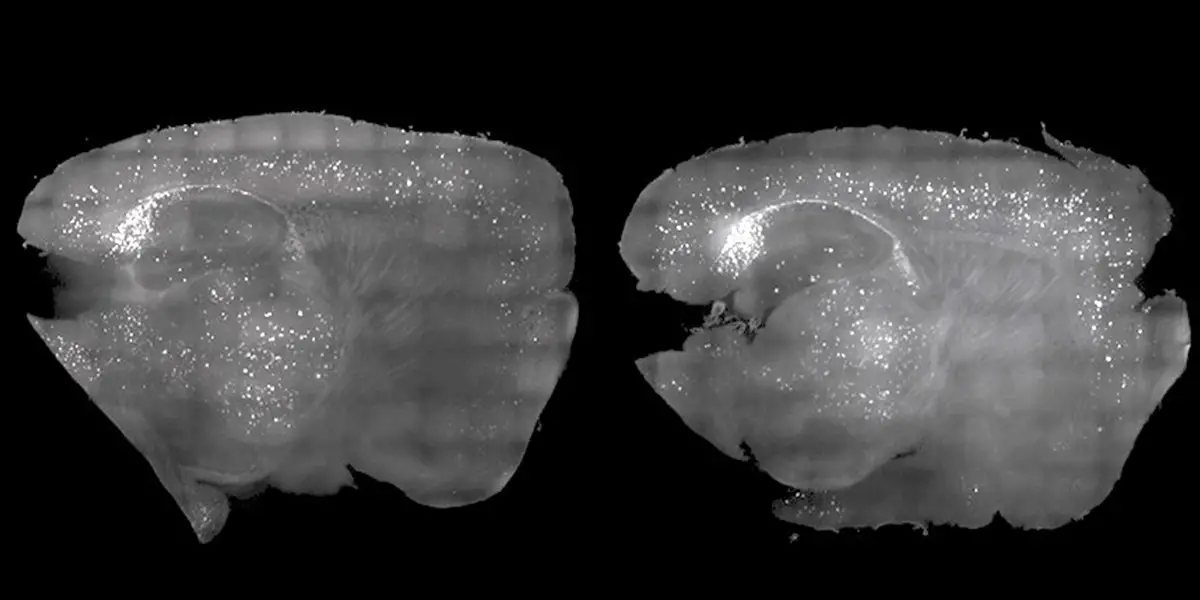Scientists Were Able To Remove Alzheimer’s Plaque From Brains Of Mice Using Light And Sound
Tags: opinion
 Mouse brain with (left) and without (right) treatment (Gabrielle Drummond)
Mouse brain with (left) and without (right) treatment (Gabrielle Drummond)
We are all aware of the deadly neurological disease – Alzheimer’s. It might be one of our greatest fears of old age. Forgetting our loved ones – forgetting even ourselves as we move forward towards death – it really sounds like one of the most terrible things to happen. That’s why scientists are trying to do their best to bring about a change in the scenario. And they are progressing too.
In recent research done by researchers at MIT, scientists were able to partially clear off harmful proteins and plaque that might interfere with the brain functions of mice. They were able to direct strobes of light and use low buzz sound to recreate the brain waves thereby bringing an improvement in the cognitive functions of the mice which were engineered in a way that it would display Alzheimer’s-like behavior.
It was not done on humans yet and since brain waves work differently on both humans and animals, our hopes should not get too high. But nonetheless, it is an exciting development. If it turns out to work with humans, it can be used to develop a drug-free method to treat conditions like dementia.
This research was a follow-up of a previous study which displayed that by flashing light about 40 times in one second on the eyes of mice engineered with Alzheimer’s symptoms brought about a marked improvement in their condition. Now adding the sound, tuned to a similar frequency, found that the results improved drastically. According to Li-Huei Tsai, one of the researchers of the Picower Institute for Learning and Memory at MIT, there was a dramatic reduction of the amyloid and prefrontal cortex engagement. It also brought up the role of sounds in clearing up amyloid proteins and clumps of Tau which are partially the cause of Alzheimer’s.
Studies have shown that it was possible to use ultrasound to make blood vessels become a little leaky, which in turn, made it easy to slip different treatments to the brain. It also encouraged microglia, the waste-removing components of the nervous system, to remove the wastes fast.
The previous ‘light’ treatment was quite a mind-boggling discovery as Tsai told Nature. But there was one drawback. The ‘light’ treatment only affected the visual centers of the brain only – missing out on areas like memory retrieval centers. Tsai explains how this thing works. In our brain, neurons send out these signals which also generate brain waves or electromagnetic waves. Gamma frequencies of oscillations take place and they ripple through the brain at 30-90 waves per second. When we are attentive on something, these brain waves get its most power.
As per a previous study that was done by Tsai, it was these gamma rays that got impeded, thereby, developing Alzheimer’s in people.
The light could play the trick in generating more gamma rays. Similarly, ultrasound at 40 Hertz could also drop the amyloid buildup with about an hour of exposure. It will also stimulate blood vessels and microglial cells.
Tsai says that they were able to show how different sensory modalities can be used to influence gamma rays in the brain. Plus, using a sound-light combination helped them get close to the memory centers of the brain too. Cognitive functions got a required boost as well among mice.
Now, all that is required is to see if the experiment can be translated to human subjects as well. This could be difficult as there are clear contrasts between gamma rays in humans and mice. Preliminary safety tests have not shown any side-effects as of now. The entire study has been published in Cell.
Let’s hope the best comes out of it.
Leave Comment: